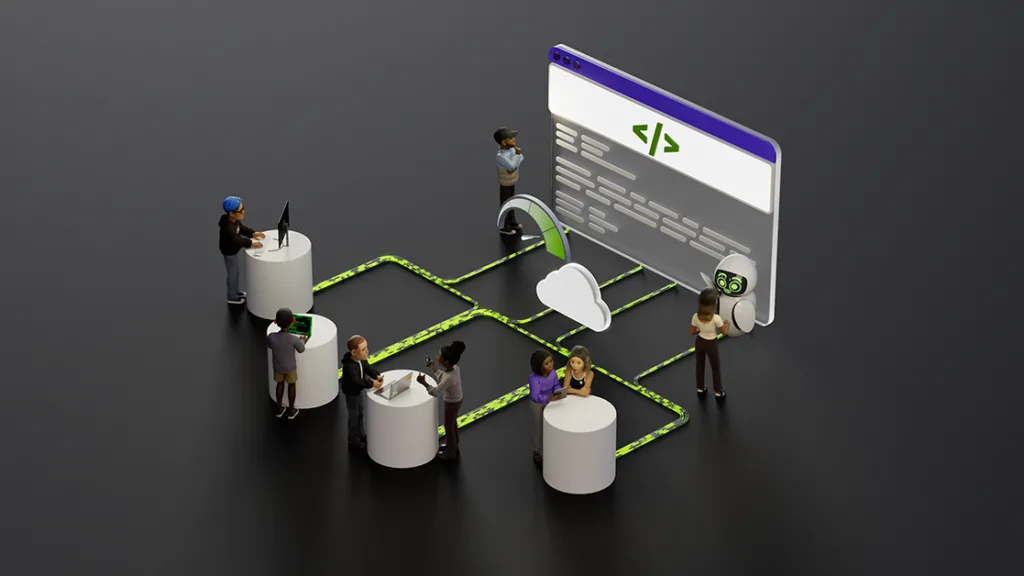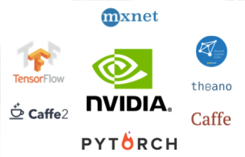Open source AI models such as Cosmos, DeepSeek, Gemma, GPT-OSS, Llama, Nemotron, Phi, Qwen, and many more are the foundation of AI innovation. These models are democratizing AI by making model weights, architectures, and training methodologies freely available to researchers, startups, and organizations worldwide.
Developers everywhere can learn and build on innovative techniques including mixture-of-experts (MoE), new attention kernels, post-training for reasoning, and more—without starting from scratch. As explained in this post, this democratization is amplified through broad availability of NVIDIA systems and open source software specifically designed to accelerate AI, from the cloud and data center to desktops and edge devices.
How do NVIDIA Blackwell and NVFP4 accelerate AI at scale?
NVIDIA Blackwell GPU architecture is a purpose-built AI superchip. It packs fifth-generation Tensor Cores and a new numerical format, NVFP4 (4-bit floating-point), to deliver massive compute performance with high accuracy. This architecture also integrates NVIDIA NVLink‑72 next-generation high-bandwidth interconnect, enabling ultra-fast GPU-to-GPU communication and scaling across multi-GPU configurations for demanding AI workloads. Blackwell GPUs also include second-generation Transformer Engines, and NVLink Fusion.
How do open source tools scale AI innovation?
Accelerating AI requires more than powerful hardware and open source AI models—it demands an optimized and rapidly evolving software stack to deliver optimal performance for today’s demanding AI workloads.
NVIDIA is democratizing access to cutting-edge AI capabilities by releasing open source tools, models, and datasets for developers to innovate at the system level. You can find 1,000+ open source tools through NVIDIA GitHub repos, and the NVIDIA Hugging Face collections offer 450+ models and 80+ datasets.
This comprehensive approach to open source extends across the NVIDIA software stack—from fundamental data processing tools to complete AI development and deployment frameworks. NVIDIA publishes multiple open source CUDA-X libraries that accelerate entire ecosystems of interconnected tools, ensuring that developers can leverage the full potential of open source AI on cutting-edge hardware like Blackwell.
How does the open source AI tool development pipeline work?
The open source AI tool development pipeline begins with data preparation and analytics. RAPIDS is an open source suite of GPU-accelerated Python libraries for accelerating the data preparation and ETL (Extract, Transform, Load) pipeline that feed directly into model training. RAPIDS ensures that AI workloads can run end-to-end on GPUs, eliminating costly CPU bottlenecks and enabling faster training and inference.
Once the data pipeline is accelerated, the next step is model training. NVIDIA NeMo framework is an end-to-end training framework for large language models (LLMs), multimodal models, and speech models. It enables seamless scaling of pretraining and post-training workloads from a single GPU to thousand-node clusters for Hugging Face/PyTorch and Megatron models.
NVIDIA PhysicsNeMo is a framework for physics-informed machine learning (Physics-ML) that enables researchers and engineers to integrate physical laws into neural networks, accelerating digital twin development and scientific simulations. NVIDIA BioNeMo brings generative AI to the life sciences, providing pretrained models as accelerated NVIDIA NIM microservices, as well as tools for protein structure prediction, molecular design, and drug discovery—empowering researchers to accelerate breakthroughs in biology and healthcare.
These frameworks leverage NCCL, an open source CUDA-X library for multi-GPU and multi-node collective communication. NVIDIA NeMo, PhysicsNeMo, and BioNeMo extend PyTorch with advanced generative capabilities, enabling developers to build, customize, and deploy powerful generative AI applications beyond standard deep learning workflows.
After models are trained, developers need to serve them efficiently. The NVIDIA TensorRT inference stack, including TensorRT-LLM and TensorRT Model Optimizer, provides optimized kernels and quantization tools for deploying models at scale. TensorRT-LLM taps the new Blackwell instructions and FP4 format to push performance even further, resulting in faster and more memory-efficient inference on large models.
Kernel developers implementing custom solutions use CUTLASS, an open source collection of CUDA C++ templates. CUTLASS makes it easier to write high-performance GPU kernels for matrix-matrix multiplication (GEMM), the backbone of deep learning.
NVIDIA Dynamo helps to efficiently serve users at scale. The open source framework-agnostic inference-serving platform supports PyTorch, TensorRT-LLM, vLLM, and SGLang. Designed to scale reasoning AI by disaggregating the different stages of inference and using intelligent LLM-aware scheduling, Dynamo maximizes token throughput in AI factories.
Dynamo also includes NIXL, an open source high-throughput, low-latency communication library optimized for data movement in AI inference environments. The latest results on Dynamo 0.4 with TensorRT-LLM are striking. For long input sequence lengths, it delivers up to 4x faster interactivity for the OpenAI GPT-OSS 120B model on NVIDIA B200 Blackwell GPUs without throughput tradeoffs. With the DeepSeek-R1 671B model on NVIDIA GB200 NVL72, it achieves 2.5x higher throughput per GPU without increasing inference costs.
Open source models and datasets
Frameworks are only half the story—developers also need open models and datasets to experiment, fine-tune, and deploy at scale. That’s why NVIDIA complements open source tools with a growing library of open models and datasets.
On Hugging Face, NVIDIA has released hundreds of models and datasets covering language, vision, multimodal, and robotics. This includes:
- NVIDIA Nemotron family, fully open models for agentic AI that deliver best reasoning accuracy and performance efficiency
- Foundation and reasoning models for physical AI, such as NVIDIA Cosmos
These models use permissive licenses including the NVIDIA Open Model License to encourage adoption and innovation. In total, NVIDIA open source projects and models are integrated into millions of developer workflows, from academic research to cloud services, magnifying the impact of Blackwell GPUs.
NVIDIA Nemotron is a reasoning-capable LLM family built for highest accuracy and performance. These open models are architected for efficient inference and fine-tuning. They achieve up to 6x the throughput compared to next best open, leading models by using techniques like pruning and hybrid architecture. They are tuned with high-quality, NVIDIA-built and curated, open training datasets using techniques like distillation, SFT, and reinforcement learning to achieve best accuracy for reasoning and agentic tasks. The models are packaged as NIM inference microservice to easily deploy on any GPU-accelerated systems, from desktop to data center. This enables enterprises to experiment with multistep reasoning models and fine-tune them efficiently for custom applications.
NVIDIA has also released multimodal models such as Isaac GR00T N1.5—an open, customizable, vision language action (VLA) model for humanoid robotics enabling robot reasoning and understanding—as well as embedding models, tokenizers, and more. Many of these models are already prequantized for NVFP4, and all are distributed with permissive licenses.
But AI doesn’t stop at text or images—developers want to simulate, reason, and interact with the physical world. NVIDIA is helping advance physical AI, which perceives and interacts with the physical world (robots, autonomous vehicles, and smart infrastructure, for example). A key part of this vision is NVIDIA Cosmos, a suite of generative models and tools for world generation and understanding, accelerating physical AI model development. Cosmos comprises three core models: Predict, Transfer, and Reason. It also includes tokenizers and data processing pipelines, all released under the open model license to enable developers to download and adapt.
These simulation and reasoning frameworks are further enhanced by the NVIDIA Omniverse SDKs and libraries, which use open source Universal Scene Description (OpenUSD) for data aggregation and scene assembly. NVIDIA has contributed real-time RTX rendering extensions and physics schemas enabling developers to build physical AI applications for industrial and robotics simulation use cases. These technologies collectively establish a comprehensive sim-to-real pipeline for training AI systems that function in real-world environments.
From RAPIDS accelerating raw data processing to open models like Cosmos and Nemotron, the NVIDIA open ecosystem covers the entire AI lifecycle. By integrating open tools, models, and frameworks across every stage, developers can move from prototype to production on Blackwell hardware without leaving the open source ecosystem.
Get started with the NVIDIA open AI ecosystem
The NVIDIA AI software stack is already powering millions of developer workflows worldwide from academic research labs to Fortune 500 companies, enabling teams to harness the full potential of cutting-edge GPUs like Blackwell. By combining breakthrough hardware innovations such as NVFP4 precision, second-generation Transformer Engines, and NVLink Fusion with an unmatched collection of open source frameworks, pretrained models, and optimized libraries, NVIDIA ensures that AI innovation scales seamlessly from prototype to production.
And the best part? You can try it all today. Explore open source projects on GitHub, access hundreds of models and datasets on Hugging Face, or dive deeper into NVIDIA open source project catalog. Whether you’re building LLMs, generative AI, robotics, or optimization pipelines, the ecosystem is open and ready for your next breakthrough.
About NVIDIA’s contribution to open source: NVIDIA is an active contributor to major projects such as the Linux Kernel, Python, PyTorch, Kubernetes, JAX, and ROS. Additionally, NVIDIA strengthens open source ecosystems by contributing to foundations, including the Linux Foundation, PyTorch Foundation, Python Software Foundation, Cloud Native Computing Foundation, Open Source Robotics Alliance, and The Alliance for OpenUSD. Beyond these large organizations, NVIDIA also invests in smaller communities through initiatives like its Free and Open Source Software (FOSS) Fund. Many NVIDIA engineers serve as core developers and maintainers across leading open source ecosystems, helping to sustain the projects that power AI innovation worldwide.









